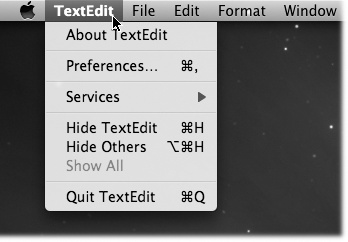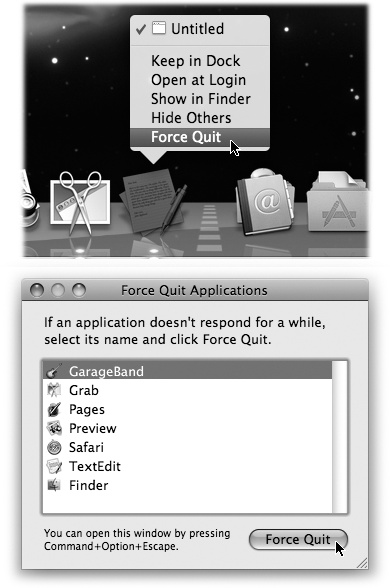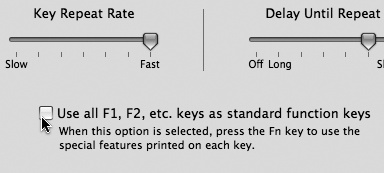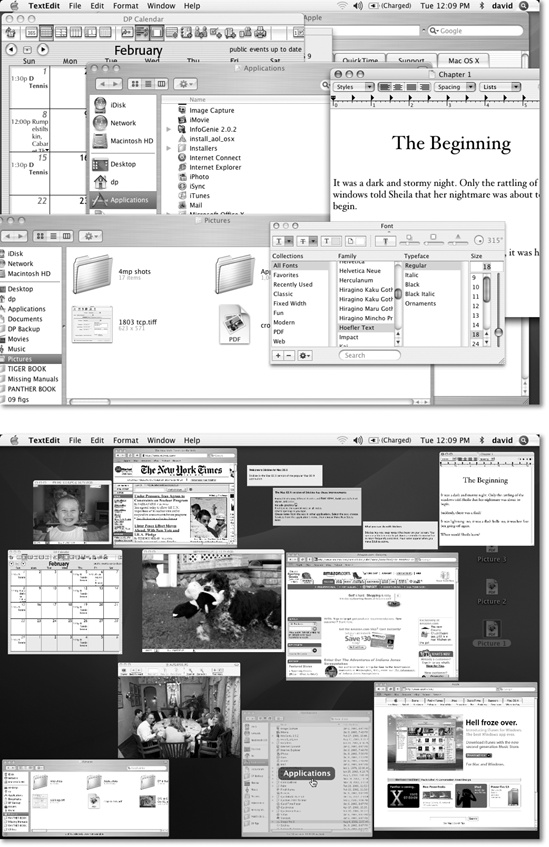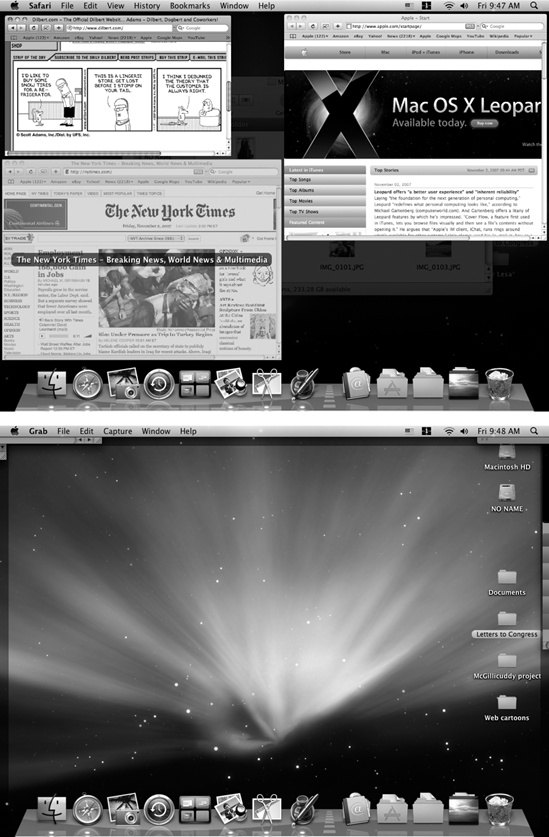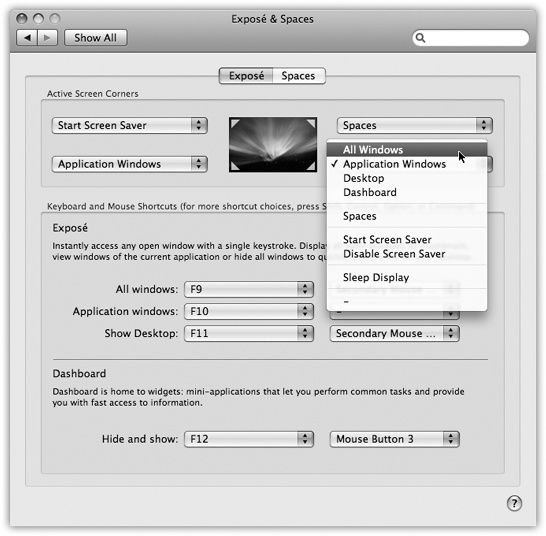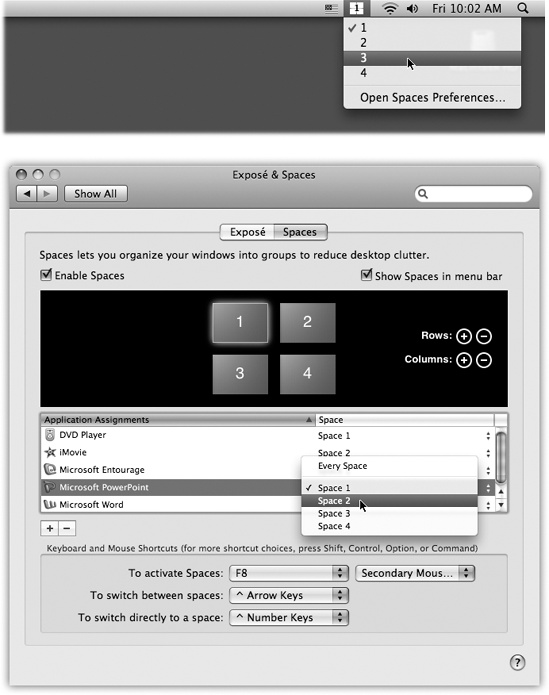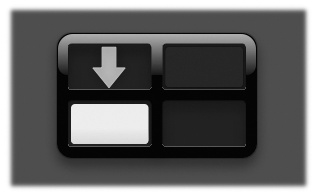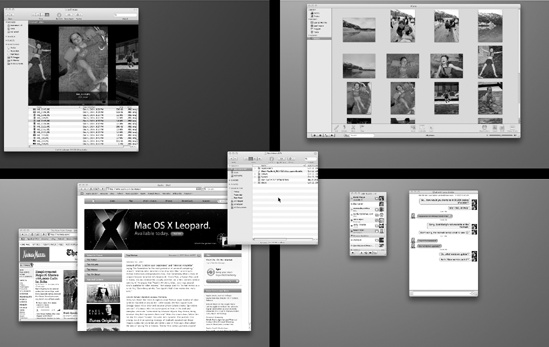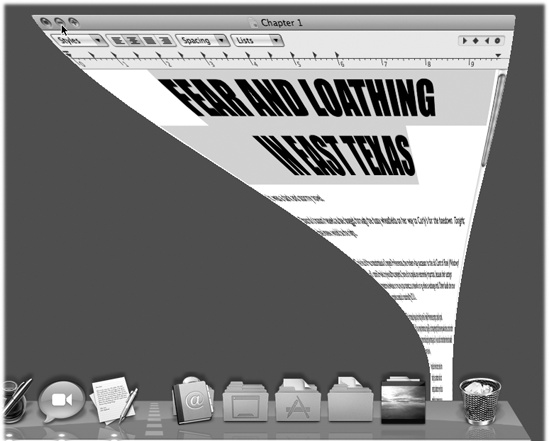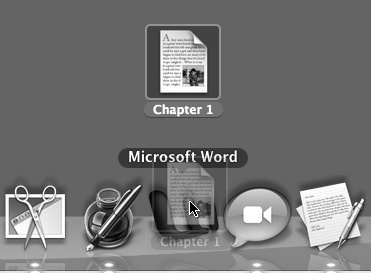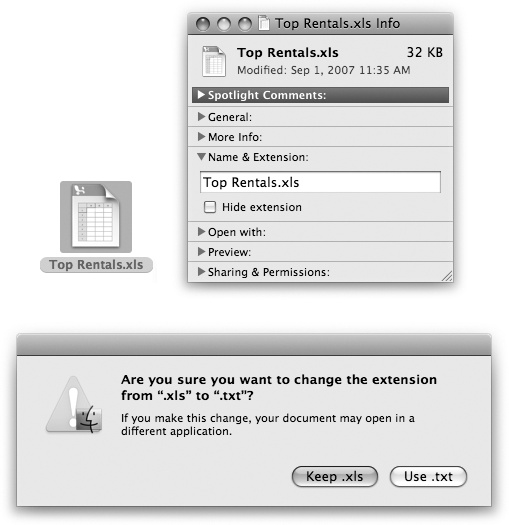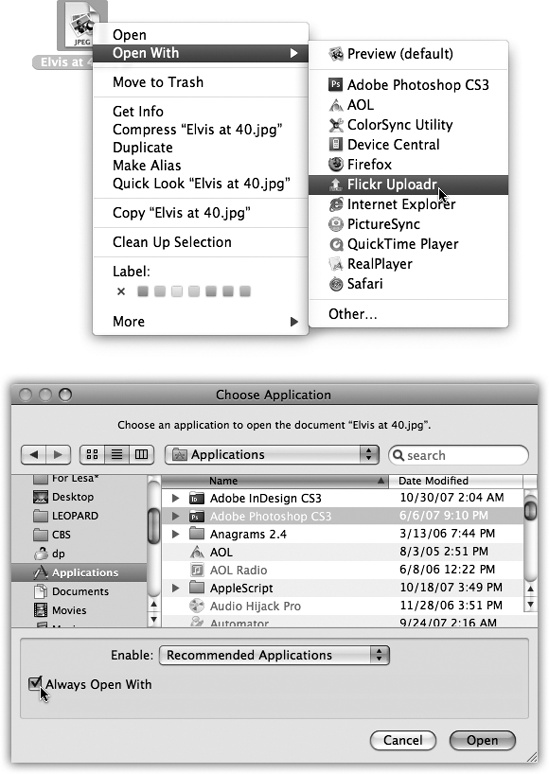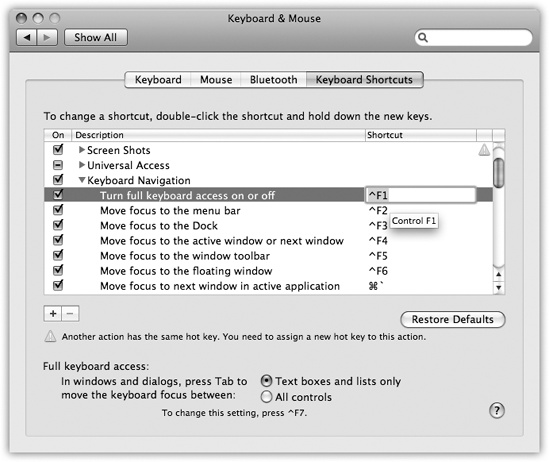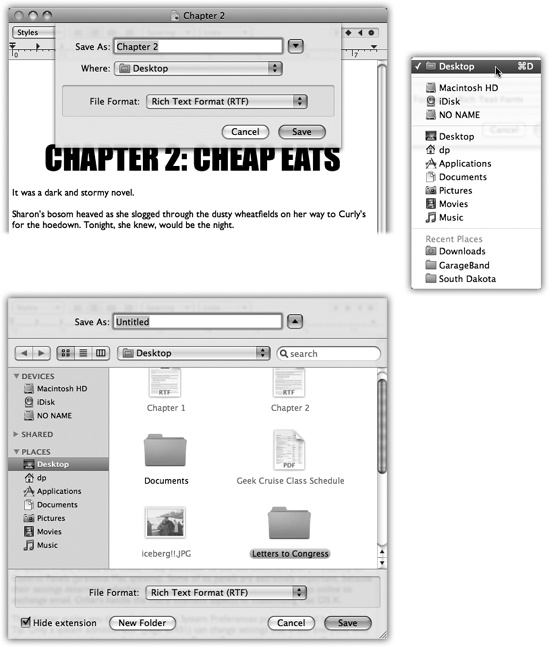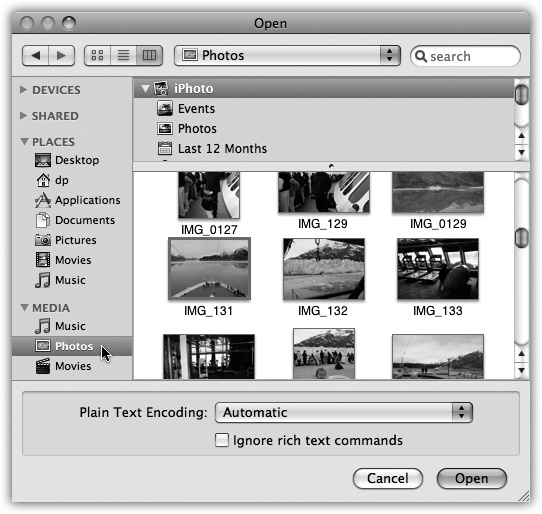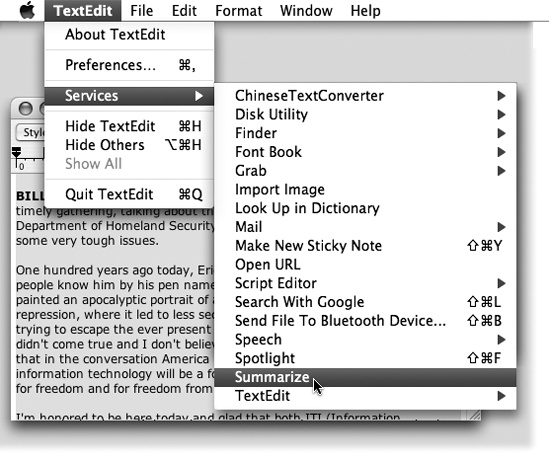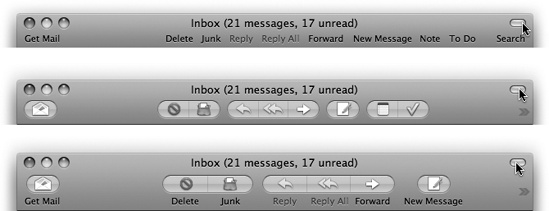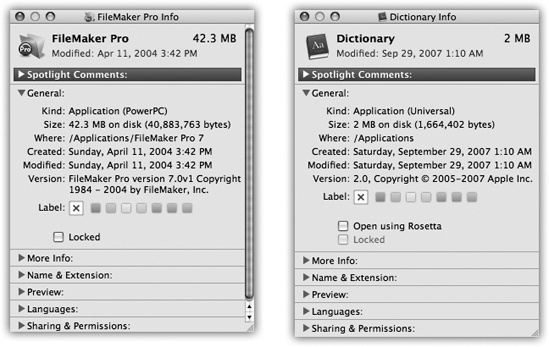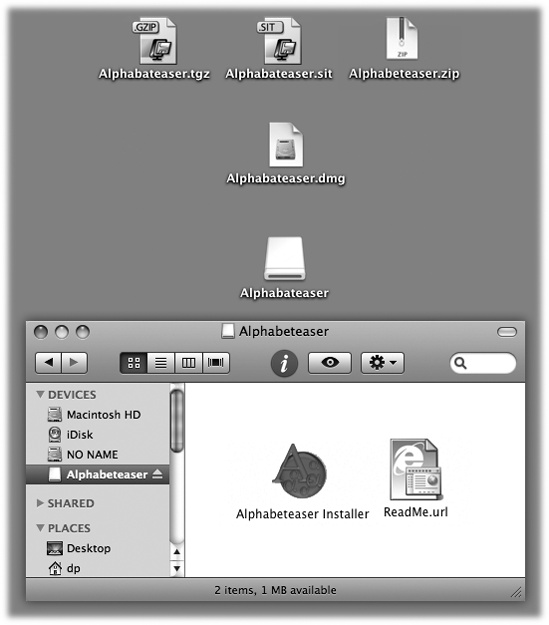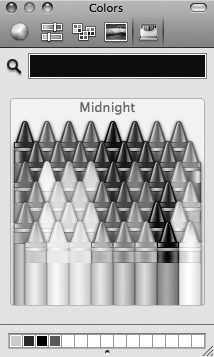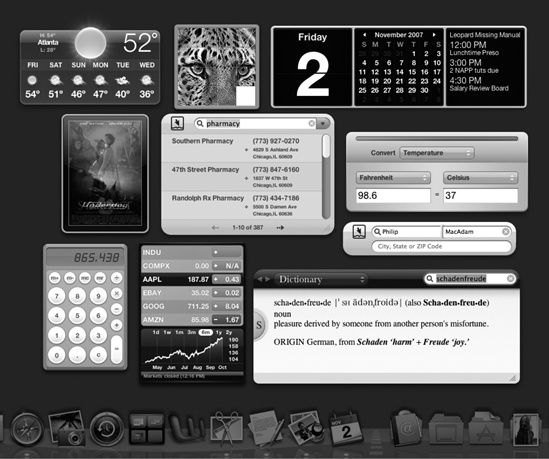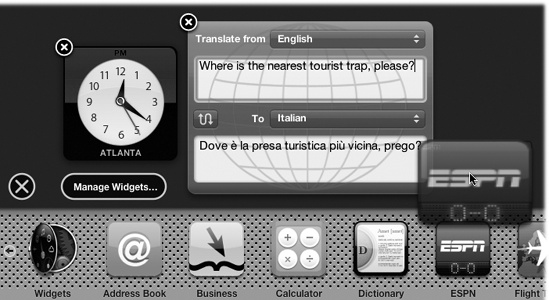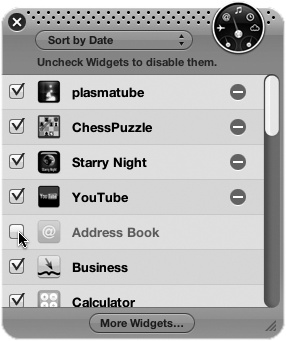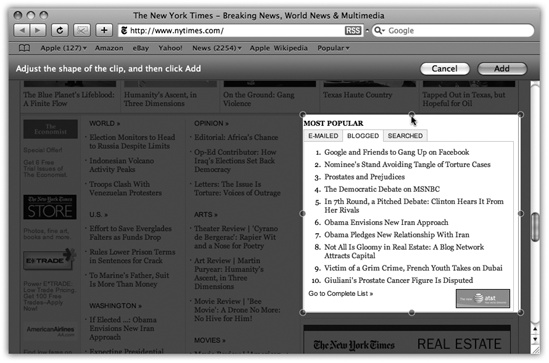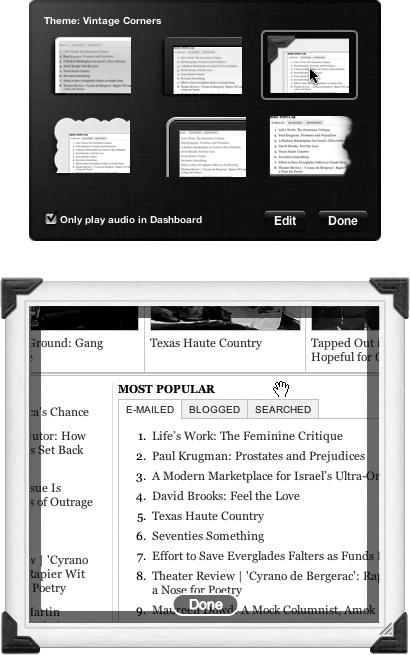The beauty of life in the Era of Switchers is that most of the big-boy programs are available in nearly identical versions for both the Mac and Windows. Word, Excel, and PowerPoint; Photoshop, Illustrator, and InDesign; FileMaker Pro; Dreamweaver; and many other programs are available for both Mac and Windows. Sometimes you have to buy the Mac version separately; sometimes it’s on the same CD.
The best part: The documents you create with the Mac versions are generally identical in format to the ones created in Windows. A Microsoft Word document, for example, requires no conversion when transferred from a Mac to a PC or vice-versa. It is what it is—a .doc or .docx file.
Same thing with Excel spreadsheets (.xls), PowerPoint slideshows (.ppt), Photoshop documents (.psd), and on and on. You may occasionally encounter a tiny formatting difference—a line thickness change, a movie file that requires a plug-in—but most documents open flawlessly when moved between Macs and PCs. (Chapter 7 offers more detail on finding Mac versions of your favorite PC programs.)
But even if switching to the Mac OS X versions of your programs is relatively easy, learning how Mac OS X programs in general operate may require some study. As this chapter makes clear, the relationship between programs and their documents differs in several substantial ways from the way things work in Windows.
Many of the techniques for launching (opening) a program work just as they do in Windows. For example:
Click a program’s icon on the Dock, the Sidebar, or the Finder toolbar.
Use Spotlight. Hit
 -Space bar, type the first letters of the
program’s name, and then press Return or Enter.
-Space bar, type the first letters of the
program’s name, and then press Return or Enter.Double-click an application’s icon in the Finder.
Highlight an application icon and then press
 -O (short for File→Open) or
-O (short for File→Open) or
 -down arrow.
-down arrow.Use the submenus of the
 menu’s Recent Items→Applications
command.
menu’s Recent Items→Applications
command.Open a document icon in any of these ways, or drag a document onto the icon of a program that can open it (whether in the Dock, the Finder toolbar, the Sidebar, or in a folder window).
Tip
If you press Option as you open an application (or anything else) in the Finder, you automatically close the window that contains its icon. Later, when you return to the Finder, you’ll find a neat, clean desktop—no loitering windows.
When you launch a program, the Mac reads its computer code, which lies on your hard drive’s surface, and feeds it quickly into RAM (memory). During this brief interval, the icon of the opening program jumps up and down eagerly in your Dock.
Tip
Want to see multithreading in action? Launch a program that takes a long time to open—that is, whose icon in the Dock does a lot of bouncing.
You don’t have to wait for the application to finish bouncing—you’re wasting perfectly good computing time. Just switch to another program and get to work; the newly opened program keeps right on launching in the background. Multithreading means that Mac OS X can crunch more than one process at a time.
What happens next depends on the program you’re using. Most present you with a new, blank, untitled document. Some, like iDVD, automatically open the last file you worked on. Some, like FileMaker and PowerPoint, ask if you want to open an existing document or create a new one.
And a few oddball programs don’t open any window at all when first launched.
In each case, however, the very first menu after the
![]() appears with bold lettering and identifies
the program you’re using. It might say iTunes, or Microsoft Word, or
Stickies.
appears with bold lettering and identifies
the program you’re using. It might say iTunes, or Microsoft Word, or
Stickies.
This Application menu Figure 4-1 offers a number of commands pertaining to the entire program and its windows, including About, Quit, and Hide.
In Macintosh lingo, you don’t “exit” a program when you’re finished with it, you “quit” it. And the command to do so isn’t in the File menu—it’s at the bottom of the Application menu.
But Mac OS X offers two much more fun ways to quit a program:
Right-click a program’s Dock icon and then choose Quit from the pop-up menu.
When you’ve pressed
 -Tab to summon Leopard’s “heads-up
display” of open programs (The New, Improved “Alt-Tab”), type the
letter Q without releasing the
-Tab to summon Leopard’s “heads-up
display” of open programs (The New, Improved “Alt-Tab”), type the
letter Q without releasing the  key. The highlighted program quits
without further ado.
key. The highlighted program quits
without further ado.
Mac OS X is a rock-solid operating system, but that doesn’t mean that programs never screw up. Individual programs are as likely as ever to freeze—or, rather, to hang (to lock up and display the “spinning beach ball of death” cursor). In such cases, you have no choice but to force quit the program—or, in Windows lingo, to terminate it or “end its task.”
Figure 4-2. Top: You can force quit a program from the Dock, thanks to
the Option key. Bottom: When you press Option-![]() -Esc or choose Force Quit from the
-Esc or choose Force Quit from the
![]() menu, a tidy box listing all open programs
appears. Just click the one you want to abort, click Force Quit,
and click Force Quit again in the confirmation box. Often, you may
have to force quit a program twice to make it really go away.
(Using more technical tools like the Unix
kill command, there are other ways to
jettison programs. But this is often the most convenient.)
menu, a tidy box listing all open programs
appears. Just click the one you want to abort, click Force Quit,
and click Force Quit again in the confirmation box. Often, you may
have to force quit a program twice to make it really go away.
(Using more technical tools like the Unix
kill command, there are other ways to
jettison programs. But this is often the most convenient.)
Doing so doesn’t destabilize your Mac; you don’t have to restart it. In fact, you can usually reopen the very same program and get on with your life.
You can force quit a stuck program in any of several ways:
Right-click its Dock icon, or just hold your mouse down on it. Once the shortcut menu appears, press Option so that the Quit command now says Force Quit (see Figure 4-2). Bingo—that program is outta here.
Press Option-
 -Esc, the traditional Mac force quit
keystroke.
-Esc, the traditional Mac force quit
keystroke.
Either way, proceed as shown in Figure 4-2.
Again, force quitting is not bad for your Mac. The only downside to force quitting a program is that you lose any unsaved changes to your open documents, along with any preference settings you may have changed while the program was open.
Only one program can be in front, or active, at a time. Just as
in Windows, there’s a handy keystroke for switching from one to
another; it’s the ![]() -Tab keystroke (see Figure 4-3).
-Tab keystroke (see Figure 4-3).
Figure 4-3. Apple calls this row of open program icons a “heads-up display,” named after the projected data screens on a Navy jet windshield that lets pilots avoid having to look down at their instruments.
You can use this feature in three different ways, which are well worth learning:
If you keep the
 key pressed, each press of the Tab key
highlights the Dock icon of another program, in left-to-right Dock
order. Release both keys when you reach the one you want. Mac OS X
brings the corresponding program to the front. (To move backward
through the open programs, press Shift-
key pressed, each press of the Tab key
highlights the Dock icon of another program, in left-to-right Dock
order. Release both keys when you reach the one you want. Mac OS X
brings the corresponding program to the front. (To move backward
through the open programs, press Shift- -Tab.)
-Tab.)If you leave the
 key pressed, you can choose a program by
clicking its icon with your mouse.
key pressed, you can choose a program by
clicking its icon with your mouse.A single press of
 -Tab takes you to the program you used most
recently, and another, separate
-Tab takes you to the program you used most
recently, and another, separate  -Tab bounces back to the program you started
in.
-Tab bounces back to the program you started
in.Imagine that, for example, you’re doing a lot of switching between two programs—your Web browser and your email program, for example. If you have five other programs open, you don’t waste your time
 -Tabbing your way through all open programs
just to “get back” to your Web browser.
-Tabbing your way through all open programs
just to “get back” to your Web browser.
In its day, the concept of overlapping windows on the screen was brilliant, innovative, and extremely effective. (Apple borrowed this idea from a research lab called Xerox PARC.) In that era before digital cameras, MP3 files, and the Web, managing your windows was easy this way; after all, you had only about three of them.
These days, however, managing all the open windows in all the open programs can be like herding cats. Off you go, burrowing through the microscopic pop-up menus of your taskbar buttons (Windows) or the Dock (Mac OS X 10.5), trying to find the window you want. And heaven help you if you need to duck back to the desktop—to find a newly downloaded file, for example, or eject a disk. You’ll have to fight your way through 50,000 other windows on your way to the bottom of the “deck.”
Exposé represents the first fresh look at this problem in decades. The concept is delicious: With the press of the F9 key, Mac OS X shrinks all windows in all programs to a size that fits on the screen (Figure 4-4), like index cards on a bulletin board. You click the one you want, and you’re there. It’s fast, efficient, animated, and a lot of fun.
Figure 4-4. Top: Quick! Where’s the Apple Web page in all this mess? Bottom: With a tap of the F9 key, you can spot that window, shrunken but not overlapped. As your cursor passes over each thumbnail, the window darkens and identifies itself, courtesy of the floating label in its center. What’s especially cool is that these aren’t static snapshots of the windows at the moment you Exposé'd them. They’re live, still-updating windows, as you’ll discover if one of them contains a QuickTime movie during playback or a Web page that’s still loading. If you’re not pointing to a window, tapping F9 again turns off Exposé without changing anything; if you’re pointing to a window, tapping F9 again brings it forward.
Note
On the superthin aluminum Apple keyboards, use the F3 key instead of F9. The painful details are in the box below.
That business about finding a buried window on your screen is probably the way you’ll use Exposé most often. But it’s actually only one of three Exposé functions. The other options:
A second Exposé keystroke is designed to help you find a certain window only in the program you’re using—great when you’re Web browsing or word processing. When you tap F10 (the factory setting), all of the windows in the frontmost program spread out and shrink, if necessary, so you can see all of them simultaneously, in full—and so you can click the one you want (see Figure 4-5, top).
Note
As noted in the box in TROUBLESHOOTING MOMENT: A Tedious Sidebar about the Aluminum Apple Keyboards, you may have to add the Fn key (that is, press Fn+F9) if you have Apple’s superthin, iMac-style keyboard.
And now, tips:
While your application windows are arrayed before you, tap the Tab key to switch to the next running program. All of its windows spring to the fore, and all of the other programs’ windows grow dim. (Shift-Tab, as usual, cycles through the programs in the opposite direction.)
Suppose you pressed F9 to shrink all programs’ windows, but you decide that what you really meant to do was press F10 to see only one program’s windows. The solution is to press the Tab key, which switches you into F10 mode, dimming (and restoring to full size) all programs’ windows but one. At this point, you can press Tab or Shift-Tab to cycle through the open programs as described in the preceding paragraph.
Here’s another way to change programs once you’ve “F10'ed”
your windows: Press ![]() -Tab to bring up the “heads-up display”
application switcher (yes, even while your windows are shrunken).
Tab your way through the program icons (Figure 4-5) until the one
you want is selected, and then release the keys. That program’s
windows spring to the front, still miniaturized and arrayed for
your selection pleasure.
-Tab to bring up the “heads-up display”
application switcher (yes, even while your windows are shrunken).
Tab your way through the program icons (Figure 4-5) until the one
you want is selected, and then release the keys. That program’s
windows spring to the front, still miniaturized and arrayed for
your selection pleasure.
The third keystroke (F11 is the factory setting) is surprisingly handy. It sends all windows in all programs cowering to the edges of your screen, revealing the desktop beneath in all its uncluttered splendor (Figure 4-5, bottom). There they remain—forever, or until you tap F11 again, click a visible window edge, double-click an icon, or take some other window-selection step.
Note
Once again: On Apple’s superthin, iMac-style keyboard, press Fn+F11 instead. See the box in TROUBLESHOOTING MOMENT: A Tedious Sidebar about the Aluminum Apple Keyboards.
Figure 4-5. Top: When you press the F10 key, you get a clear shot at any window in the current program (Safari, in this example). In the meantime, the rest of your screen attractively dims, as though someone has just shined a floodlight onto the windows of the program in question. It’s a stunning effect. Bottom: Tap the F11 key when you need to duck back to the desktop for a quick administrative chore. Here’s your chance to find a file, throw something away, eject a disk, or whatever, without having to disturb your application windows. In either case, tap the same function key again to turn off Exposé. Or click one of the window edges, which you can see peeking out from all four edges of the screen.
This is a spectacular opportunity to save headache and hassle in situations like these:
You’re writing an email message, and you want to attach a file. Tap F11, root around in the Finder until you locate the file you want. Begin to drag it, and then tap F11 again to bring back your email window. Move your cursor, with the file in mid-drag, directly over the outgoing message window; release the cursor to create the attachment.
Tip
You can apply the same life-changing shortcut to dragging a graphic into some page-layout program, a folder of photos into iPhoto, a sound or graphic into iMovie, and so on.
You want to open a different document. For many people, having access to the entire Finder beats the pants off having to use the Open dialog box. Double-clicking the icon you want automatically opens it and turns off Exposé.
You’re on the Web, and you want to see if some file has finished downloading. Tap F11 to survey the situation on your desktop.
In essence, Apple has finally realized that the desktop really isn’t “just another program.” If the layer of open programs is the atmosphere, the Finder is the earth below—and the ability to teleport you back and forth is a huge time saver.
Tip
You can switch among the three Exposé modes (F9, F10, or F11), even after you’ve triggered one. For example, if you press F10 to shrink only one program’s windows, you can then press F11 to see the desktop, and then press F9 to shrink all programs’ windows.
Most of the time, you’ll probably use Exposé in two steps. You’ll tap the function key once to get the windows out of the way, and tap it again to bring them back (if, indeed, you haven’t clicked a window to bring them back).
In some cases, though, you may find it easier to hold down the relevant key. For example, hold down F11 to see if a file is finished copying to the desktop, then release the key to bring back all of the windows. For quick window-clearing situations, that method saves you the step of having to press the key a second time to turn off Exposé.
Exposé is wonderful and all, but the standard keys for triggering its three functions—F9 to expose all windows, F10 for current-application windows, F11 for show-me-the-desktop—may leave something to be desired. For one thing, they may already be “taken” by other functions in your programs (like Microsoft Word) or even by your computer (like certain PowerBook G4 models, whose F9 and F10 keys adjust the keyboard illumination). For another thing, those keys are at the top of the keyboard where your typing fingers aren’t used to going, and you may have to hunt to make sure you’re pressing the right one.
Fortunately, you can reassign the Exposé functions to a huge
range of other keys, with or without modifiers like Shift, Control,
and Option. To view your options, choose ![]() →System Preferences and then click the Exposé
& Spaces icon (Figure 4-6).
→System Preferences and then click the Exposé
& Spaces icon (Figure 4-6).
Here, you’ll discover that you can trigger Exposé’s functions in any of three ways:
The four pop-up menus (Figure 4-6) represent the four corners of your screen. Using these menus, you can assign an Exposé trigger to each corner; for example, if you choose Desktop from the first pop-up menu, when your pointer hits the upper-left corner of the screen, you’ll hide all windows and expose the desktop. (To make the windows come back, click any visible edge of a window, or twitch the cursor back into the same corner.)
Figure 4-6. You can trigger Exposé in any of three ways: by twitching your cursor into a certain corner of the screen (top), pressing a key (lower left), or clicking the extra buttons on a multibutton mouse (lower right), including Apple’s Mighty Mouse. Of course, there’s nothing to stop you from setting up all three ways, so you can press in some situations and twitch or click in others.
Depending on the size of your screen, this option can feel awkward at first. But if you’ve run out of keystrokes that aren’t assigned to other functions, be glad that Apple offers you this alternative.
Also in the Dashboard & Exposé preferences, you’ll find three pop-up menus—“All windows,” “Application windows,” and “Show Desktop”—that correspond to the three functions of Exposé as described above. (The fourth pop-up menu, Dashboard, is described at the end of this chapter.) You can’t assign any old keystroke to Exposé, but you have far more options than the puny F9, F10, and F11 keys.
Within each pop-up menu, for example, you’ll discover that
all of your F-keys are available as triggers: F1, F2, F3, and so
on. If, while the pop-up menu is open, you press one or more of
your modifier keys (Shift, Option, Control, or ![]() ), all of these F-key choices
change to reflect the key you’re pressing;
now the pop-up menu says Shift-F1, Shift-F2, Shift-F3, and so on.
That’s how you can make Shift-F1 trigger the
hide-all-windows function, for example.
), all of these F-key choices
change to reflect the key you’re pressing;
now the pop-up menu says Shift-F1, Shift-F2, Shift-F3, and so on.
That’s how you can make Shift-F1 trigger the
hide-all-windows function, for example.
These pop-up menus also contain choices like Left Shift, which refers to the Shift key on the left side of your keyboard. That is, instead of pressing F9 to make all your windows shrink, you could simply tap the Shift key. (This is only an example. Repeat: This is only an example. Actually using the Shift key to shrink all your windows is a terrible, terrible idea, as you’ll quickly discover the next time you try to type a capital letter. This feature is intended exclusively for hunt-and-peck typists who never use the Shift key on one side.)
If you have a laptop, you’ll also find out that the Fn key is also available for Exposé—and this time, it’s a great choice, because Fn otherwise has very little direction in life. (Fn is the neglected key in the lower-left corner of a Mac laptop keyboard, or in the top middle cluster of Apple’s aluminum keyboard.)
If your mouse has more than one button, you see a second column of pop-up menus in System Preferences. Each pop-up menu offers choices like Right Mouse Button, Middle Mouse Button, and so on. Use these pop-up menus to assign the three Exposé modes (or Dashboard) to the various clickers on your mouse: right-click to hide all windows, left-side click to reveal the desktop, and so on.
Tip
No matter how you trigger Exposé, try holding down the Shift key as you do it. You’ll enjoy watching all your windows shift around with Mac OS X’s patented slow-motion animation, which can be quite a sight.
Exposé is pretty darned cool. But Leopard offers another radical step forward in window management that you may even come to prefer. It’s called Spaces.
This feature gives you two, four, six, eight, or even sixteen full-size monitors. Ordinarily, of course, attaching so many screens to a single computer would be a massively expensive proposition, not to mention the number it would do on your living space and personal relationships.
But the bonus monitors that Spaces gives you are virtual. They exist only in the Mac’s little head. You can look at only one at a time; you switch using a keystroke, a menu, or the mouse. Instead of shuffling through your windows using Exposé, you can now leave them all spread out over a much larger virtual desktop.
Just because the Spaces screens are simulated doesn’t mean they’re not useful, though. You can dedicate each one to a different program or kind of program. Screen 1 might contain your email and chat windows, arranged just the way you like them. Screen 2 can hold Photoshop, with an open document and the palettes carefully arrayed. On Screen 3: your Web browser in full-screen mode.
You can also have the same program running on multiple screens—but different documents or projects open on each one.
Now, virtual screens aren’t a new idea—this sort of software has been available for the Mac and Windows for years. But it’s never before been a standard feature of an operating system, and rarely executed with such finesse.
To “install” your new monitors, start by choosing
![]() →System Preferences. Click the Exposé &
Spaces icon, then click the Spaces tab. You see something like Figure 4-7.
→System Preferences. Click the Exposé &
Spaces icon, then click the Spaces tab. You see something like Figure 4-7.
The setup ritual goes like this:
Turn Spaces on. The “Enable Spaces” checkbox is the master on/off switch.
Add the menulet. Turn on “Show Spaces in menu bar” to make a menu of your virtual screens appear in the menu bar. It not only lets you switch screens, but the numeral on it also reminds you which screen you’re on.
Tip
Consider turning on this option, if only at first, as a safety net. Otherwise, if you don’t remember the keystroke for switching screens, you might lose one of your programs on another screen and not be able to find it!
Add rows or columns. Click the + and − buttons to add rows or columns of virtual monitors. There’s a difference between rows and columns, by the way. Not only will you eventually learn to sense where your various window setups live, but you can also move from one screen to another by bumping the mouse against the corresponding edge of your current screen—and you’ll need to know which edge.
Set up program auto-screen assignments. Spaces starts to become truly useful only when you make it part of your routine. You’ll eventually memorize where everything is: Web stuff, top left. Email, top right. Photoshop, lower left. Finder with Applications folder open, lower right.
For that reason, you can use the controls in the center of the System Preferences pane to specify onto which screen certain programs automatically go when they open. Click the + button to view your Applications folder. Double-click a program’s icon to make it appear in the list. Now use the pop-up menu in the Space column to indicate which space you want this program to live on, as shown in Figure 4-7.
Tip
You can also choose All Spaces, meaning that this program’s windows are available on every virtual screen. That’s handy if it’s something you use constantly, like a stock ticker or your phone-book program.
Figure 4-7. Use the controls at the top to specify how many virtual screens you want—how many rows, how many columns, up to 16 in all. Use the middle section to specify where you want particular programs to appear (that is, on which screen) when they open. Use the bottom controls to set up how you want to move from one screen to another.
To make a program stop opening into a certain screen, click its name, and then click the - button.
Set up keyboard or mouse triggers. Once you’ve got your majestic array of Cineplex Displays assembled, you need a way to move among them.
Spaces comes set up with the Control key as the “I’m switching
screens” key. For example, press Control- ![]() to move up one screen,
Control-
to move up one screen,
Control-![]() to move one screen to the right, and so on.
Or, if you have tons of screens, you can jump to one by number (as
indicated in the map shown in Figure 4-7): Control-1,
Control-4, Control-9, or whatever.
to move one screen to the right, and so on.
Or, if you have tons of screens, you can jump to one by number (as
indicated in the map shown in Figure 4-7): Control-1,
Control-4, Control-9, or whatever.
You’re welcome to change these keyboard assignments, however, especially if you’re already using the Control key for other functions. Use the two bottom pop-up menus.
For example, suppose you want to switch screens by pressing
the Option key rather than Control. In that case, you’d open the “To
switch between Spaces” pop-up menu, press Option, and choose
"![]() Arrow Keys.” (In these pop-up menus,
Arrow Keys.” (In these pop-up menus,
![]() means the Option key,
means the Option key, ![]() is the Shift key, and
is the Shift key, and ![]() means Control.)
means Control.)
Tip
The pop-up menu at the bottom of the window, “To activate Spaces,” lets you choose a keystroke that opens up the master map of all your screens. (See Figure 4-9.) For tips on choosing a trigger, in Screen corners.
Once you’ve got Spaces set up and turned on, the fun begins. Start by moving to the virtual screen you want. Here are some ways to do that:
Choose a virtual screen’s number from the Spaces menulet, shown in Figure 4-7.
Press Control-arrow key, or whatever keystroke you set up as described above. Or hold down Control and keep tapping the arrow key to scroll through all your screens.
Press Control-number key to jump to a screen without having to scroll.
Use the heads-up switcher (The New, Improved “Alt-Tab”), or the Dock, to select a program; Spaces switches to the proper screen automatically.
When you make a switch, you see a flash of animation as one screen flies away and another appears. You also see the display shown in Figure 4-8 to help you orient yourself among your magnificent array of virtual monitors.
Figure 4-8. This display appears momentarily when you switch screens.
The arrow shows you the screens you’re moving to and from. You can
even move diagonally. While pressing Control, press two arrow keys
on your keyboard at once (like ![]() and
and ![]() ).
).
Now that you’re “on” the screen you want, open programs and arrange windows onto it as usual.
The F8 key opens up a gigantic miniature (if there is such a thing) of your entire Spaces universe (Figure 4-9).
Figure 4-9. Press F8, or click Spaces in your Dock, to open this live master view of all the windows on all the screens. (The windows update in real time—if you’re in a chat or playing a movie, for example.) You can actually drag individual windows from one of these “window panes” (actually virtual screens) to another. In fact, you can even use the Exposé keystrokes to make all the windows on all the screens visible at once, for ease in moving them around the screens.
Clicking the Spaces icon in the Dock brings up the same display.
Note
As usual, you may run into trouble with this key if you’re using Apple’s aluminum, superflat keyboard. See the box in TROUBLESHOOTING MOMENT: A Tedious Sidebar about the Aluminum Apple Keyboards.
So what can you do here?
Get oriented. You could have sworn you opened your favorite Web site—where the heck is it? Pressing F8 gives you an instant readout of where all your windows are sitting at the moment.
Switch screens. Click any “pane” of the big-picture view to jump to the screen. Or just press its number on your keyboard (4 to open the fourth screen, for example).
Reorder the screens. Using any blank background spot as a handle, you can drag the actual panes of the big-picture view around to rearrange them. If you decide that your email screen should really be at top left, drag it there.
Move windows around. Here’s the real power of the big-picture view. As shown in Figure 4-9, you can actually drag windows from one screen to another. You can use any part of the window as a handle, not just the title bar.
Tip
If you press Shift as you drag, you move all windows that belong to the same program simultaneously.
Hit an Exposé keystroke. You can actually use the F9 and F10 Exposé keystrokes while you’re in the F8 big-picture view.
Yes, this gets kind of meta, but it’s useful when you’re trying to arrange your windows and programs among your screens. Once you’re in the F8 big-picture view, for example, you can hit F9 to see all windows on all screens scurry apart, so that nothing is covered up. Then start dragging windows onto different screens as necessary.
Tip
Once the big-picture view is open, pressing the letter C key rounds up all of your open windows, from all virtual screens, into the first space—a handy way to consolidate your world in times of disorientation. Press C again to send them back where they started.
One way to move a particular window to a different screen is to drag it in big-picture view, as shown in Figure 4-9.
But there are two other ways that don’t require entering the F8 big-picture view:
Drag a window (using its title bar as a handle) all the way to the edge of the screen. Stay there with the mouse button still down. After about a second, you’ll see the adjacent screen slide into view; you’ve just moved the window.
Click anywhere inside a window, and keep the mouse button down. Now press your screen-switching keystroke (Control-
 , for example, or Control-3). You’ve
just moved the window to the designated screen.
, for example, or Control-3). You’ve
just moved the window to the designated screen.
To be sure, these are power-user techniques that may not come naturally. But the F8 big-picture view is always waiting should you become befuddled.
Tip
What if you want to drag something from one screen (like a photo in iPhoto) into a window that’s on a different screen (like an outgoing email message)?
Two ways; take your pick. First, you can start dragging whatever it is—and then, in mid-drag, press F8 to open the big-picture view, and complete the drag directly onto the other Space (and even into the relevant window in that Space).
Another approach: Start dragging. With the mouse still
down, press ![]() -Tab to open the application switcher.
Continue the drag onto the icon of the
receiving program, and still keep the mouse button down. Mac OS
X switches to the appropriate virtual screen
automatically.
-Tab to open the application switcher.
Continue the drag onto the icon of the
receiving program, and still keep the mouse button down. Mac OS
X switches to the appropriate virtual screen
automatically.
When it comes to getting windows out of your way, nothing can touch Exposé and Spaces for speed and entertainment value. Once you’ve mastered those features, the traditional rituals of hiding windows will seem charmingly quaint. “When I was your age,” you’ll tell your grandchildren, “we used to have to hold down the Option key to hide windows!”
But you know the drill at software companies: They addeth, but they never taketh away. All of the old techniques are still around.
For the purposes of this discussion, when a program is hidden, all of its windows, tool palettes, and button bars disappear. You can bring them back only by bringing the program to the front again (by clicking its Dock icon again, for example).
If your aim is to hide only the program you’re currently using, Mac OS X offers a whole raft of approaches to the same problem. Many of them involve the Option key, as listed here:
Option-click any visible portion of the desktop. The program you were in vanishes, along with all of its windows.
Option-click any other program’s icon on the Dock. You open that program (or bring all of its windows to the front) and hide all the windows of the one you were using.
Option-click any visible portion of another program’s windows. Once again, you switch programs, hiding the one you were using at the time.
From the Application menu, choose Hide iPhoto (or whatever the program is). The Application menu is the boldfaced menu that bears the program’s name.
When you’ve highlighted a Dock icon by pressing
 -Tab to rotate
through the running programs, press the letter H key.
The program hides itself instantly. Leave the
-Tab to rotate
through the running programs, press the letter H key.
The program hides itself instantly. Leave the  key down the whole time, and after
pressing the H, press Tab again to move on to the next program.
If you release the keys while “stopped” on the program instead,
you’ll bring it forward rather than hiding it.
key down the whole time, and after
pressing the H, press Tab again to move on to the next program.
If you release the keys while “stopped” on the program instead,
you’ll bring it forward rather than hiding it.Press
 -H.
This may be the easiest and most useful trick of all (although
it doesn’t work in every program). Doing so hides the program
you’re in; you then “fall down” into the next running
program.
-H.
This may be the easiest and most useful trick of all (although
it doesn’t work in every program). Doing so hides the program
you’re in; you then “fall down” into the next running
program.
To un-hide a program and its windows, click its Dock icon
again, choose the Show All command in the Application menu, or press
![]() -Tab to summon the heads-up application
display.
-Tab to summon the heads-up application
display.
In Mac OS X, there’s more to managing your window clutter than simply hiding entire programs. You can also hide or show individual windows of a single program. In fact, Apple must believe that hiding a window will become one of your favorite activities, because it offers at least four ways to do so:
Choose Window→Minimize Window, if your program offers such a command, or press
 -M.
-M.Click the Minimize button on the window’s title bar, as shown in Figure 4-10.
Double-click the window’s title bar.
Figure 4-10. When you click the center button on a window title bar,
double-click the title bar, or press ![]() -M, you minimize that window, getting it out
of your way and off your screen. Minimizing on the Mac is a lot
like minimizing in Windows; the minimized window is now
represented by an icon on your Dock, which you can click to reopen
the window.
-M, you minimize that window, getting it out
of your way and off your screen. Minimizing on the Mac is a lot
like minimizing in Windows; the minimized window is now
represented by an icon on your Dock, which you can click to reopen
the window.
In any case, the affected window shrinks down until it becomes a new icon in the right side of the Dock. Click that icon to bring the window back.
Every operating system needs a mechanism to associate documents with the applications that created them. When you double-click a Microsoft Word document icon, for example, it’s clear that you want Microsoft Word to launch and open the document.
So how does Mac OS X know how to find a document’s mommy?
It actually has four different mechanisms.
Your preferences. If you’ve used the “Always Open with” command to specify a program (Reassigning Documents to Programs), that’s the one that opens.
Type/Creator codes. First, it checks to see if the document has an invisible, four-letter Type code and Creator code. It does that because that’s how Mac OS 9 used to recognize documents, and Mac OS X wants to ensure compatibility. (Apple used to monitor and track these four-letter codes, in conjunction with the various Mac software companies, so that no two creator codes were alike.)
The Creator code is the same for a program and the documents it creates—MSWD for Microsoft Word, FMP7 for FileMaker Pro, and so on. That’s the entire point: The creator code tells the Mac which program to open when you double-click a particular document.
The Type code, meanwhile, specifies the document’s file format: GIF, JPEG, TIFF, and so on.
When you double-click a document, Mac OS X checks to see if it has a creator code. If so, it then consults an invisible database of icons and codes, the master index that lists the correspondence between creator codes and the applications that generate them.
If the desktop file discovers a match, then the corresponding program opens the document, which now appears on your screen.
Unix database. If the document doesn’t have Type or Creator codes (and documents created by Cocoa programs—in Two Kinds of Programs: Cocoa and Carbon—generally don’t), Mac OS X consults a second internal Mac OS X database, one that’s inherited from Unix systems. The only real interaction you have with it is when you change a document’s parent to a different program, as described on the following pages. (Actually, you can open and examine the database—if you’re a programmer/geek.)
Filename extensions. A filename extension is a suffix following a period in the file’s name, as in Letter to Mom.doc. (It’s usually three letters long, but doesn’t have to be.) These, too, play a role in determining which documents open into which programs—as the operating system’s last resort.
That’s how Windows identifies its documents. If you double-click something called memo.doc, it opens in Microsoft Word. If you double-click memo.wri, it opens in Microsoft Write, and so on.
Note
Mac OS X comes set to hide most filename extensions, on the premise that they make the operating system look more technical and threatening. If you’d like to see them, however, choose Finder→Preferences, click the Advanced button, and then turn on “Show all file extensions.” Now examine a few of your documents; you’ll see that their names now display the previously hidden suffixes.
You can hide or show these suffixes on an icon-at-a-time basis, too (or a clump-at-a-time basis). Just highlight the icon or icons you want to affect, and then choose File→Get Info. In the resulting Info window, proceed as shown in Figure 4-11.
Figure 4-11. Top: In the Info window, open the Name & Extension pane. Now you can see what Mac OS X really thinks your file is called. Turn “Hide extension” on if you’d rather not see the file name suffix in the Finder. Bottom: If you try to add a suffix of your own, Mac OS X objects, in effect saying, “Hey—I’ve already got a filename extension for this, even if you can’t see it. Are you sure you know what you’re doing?” (And hallelujah—in Leopard, you can turn off this warning, if you like. Choose Finder→Preferences→Advanced pane. Turn off “Show warning before changing an extension.”)
It’s possible to live a long and happy life without knowing anything about these codes and suffixes. Indeed, the vast majority of Mac fans may never even encounter them. But if you’re prepared for a little bit of technical bushwhacking, you may discover that understanding creator/type codes and file name suffixes can be useful in troubleshooting, keeping your files private, and appreciating how Mac OS X works.
Unfortunately, Type and Creator codes aren’t of much use when you encounter a document created by a program that you don’t have. If someone emails you a MIDI file (a file-exchange format for music) that she exported from the Finale sheet-music program, you won’t be able to open it by double-clicking, unless you, too, have Finale installed. Even if you have a different sheet-music program on your hard drive, just double-clicking the MIDI file won’t, by itself, open it.
Filename extensions, meanwhile, have problems of their own. Filename extensions are even less likely to pinpoint which parent program should open a particular document. Suppose you’ve downloaded a graphic called Sunset.jpg. Well, almost any program these days can open a JPEG graphic—Photoshop, Word, Preview, Safari, and so on. How does Mac OS X know which of these programs to open when you double-click the file?
Fortunately, you can decide. You can reassign a document (or all documents of its kind) to a specific program. Here’s the rundown.
Double-clicking a graphics file generally opens it in Preview, the graphics viewer included with Mac OS X. Most of the time, that’s a perfectly good arrangement. But Preview has only limited editing powers. What if you decide to edit a graphics file more substantially? You’d want it to open, just this once, into a different program—Photoshop Elements, for example.
To do so, you must access the Open With command. You can find it in two places:
Highlight the icon, and then choose File→Open With.
Right-click the file’s icon. Or, in a Finder window, highlight the icon and then open the Action menu. In the shortcut menu, choose Open With.
Study the submenu for a moment (Figure 4-12, top). The program whose name says “(default)” indicates which program usually opens this kind of document. From this pop-up menu, choose the name of the program you’d rather open this particular file, right now, just this once.
After opening a TIFF file in, say, Photoshop Elements for editing, you haven’t really made any changes in the fabric of your Mac universe. The next time you double-click that file, it opens once again in Preview.
If you wish this particular file would always open in Photoshop Elements, the steps are slightly different. In fact, there are three different ways:
In the Choose an Application dialog box, turn on “Always Open With” (shown at bottom in Figure 4-12).
Figure 4-12. Top: The shortcut menu offers a list of programs capable of opening an icon. If you were to press the Option key right now, the words Open With would suddenly change to say Always Open With. Bottom: If you choose Other, you’re prompted to choose a different program. Turn on Always Open With if you’ll always want this document to open in the new parent program. Otherwise, this is a one-time reassignment.
Start out with one of the previously described techniques (File→Open With, or right-click the file’s icon and choose Open With)—but after you see the menu, press the Option key, too. Before your very eyes, the Open With command changes to say Always Open With.
Highlight the icon, and then choose File→Get Info. Open the “Open with” panel. Choose a new “parent” program’s name from the pop-up menu. You’ll see that the word “(default)” changes position, now tacking itself onto the name of the new program you’ve chosen.
So much for reassigning one document (or group of documents) at a time. What if you’re writing, say, a book about Mac OS X, and you’ve been taking a lot of screenshots? Mac OS X saves each captured screen illustration as a graphics file in something called PNG format. That’s all fine, except that every time you double-click one of these, it opens into Preview, where you can’t paint out unwanted details.
You could reassign all of these files, one at a time, to a different program, but your grandchildren would have grandchildren by the time you finish. In this case, you want to tell Mac OS X, “For heaven’s sake, make all PNG files open in Photoshop from now on!”
To make it happen, start by highlighting any PNG file. Choose File→Get Info. (The shortcut menus won’t help you in this case.) Open the “Open with” panel.
From its pop-up menu, choose the program you want to open this kind of document from now on. (If the one you prefer isn’t listed, use the Other option, which opens the Choose an Application dialog box so that you can navigate to the one you want. Find and double-click the program.)
This time, follow up by clicking Change All beneath the pop-up menu. (This button is dimmed until you’ve actually selected a different program from the pop-up menu.) Mac OS X asks you to confirm by clicking Continue or pressing Enter.
From now on, double-clicking any similar kind of document opens it in the newly selected program.
In Windows, of course, you can operate every menu in every program from the keyboard—and every control in every dialog box—thanks to the power of the Alt key.
Mac OS X offers full keyboard control, too. You can operate every control in every dialog box from the keyboard, including pop-up menus and checkboxes. And you can even redefine many of the keyboard shortcuts in Mac OS X and even your programs. In short, if you were a keyboard power-user in Windows, you’ll feel right at home in Mac OS X.
Here are some of the ways you can control your Mac mouselessly. In the following descriptions, you’ll encounter the factory settings for the keystrokes that do the magic—but as you’ll note in a moment, you can change these key combos to anything you like. (That’s fortunate, since many of them, out of the box, conflict with canned brightness and volume keystrokes for laptops.)
When you press Control-F2, the ![]() menu is highlighted. At this point, you can
“walk” to another menu by pressing the
menu is highlighted. At this point, you can
“walk” to another menu by pressing the ![]() or
or ![]() keys (or Tab and Shift-Tab). When you reach
the menu you want, open it by pressing
keys (or Tab and Shift-Tab). When you reach
the menu you want, open it by pressing ![]() , Space, Return, or Enter.
, Space, Return, or Enter.
Walk down the commands in the menu by pressing
![]() or
or ![]() , or jump directly to a command in the menu by
typing the first couple letters of its name. Finally, “click” a menu
command by pressing Enter, Return, or the Space bar.
, or jump directly to a command in the menu by
typing the first couple letters of its name. Finally, “click” a menu
command by pressing Enter, Return, or the Space bar.
You can also close the menu without making a selection by
pressing Esc or ![]() -period.
-period.
Once you’ve pressed Control-F3, you can highlight any icon on the Dock by pressing the appropriate arrow keys (or, once again, Tab and Shift-Tab).
Then, once you’ve highlighted a Dock icon, you “click it” by
pressing Enter or the Space bar. Again, if you change your mind,
press Esc or ![]() -period.
-period.
Every time you press Control-F4, you bring the next window forward, eventually cycling through every window in every open program. Add the Shift key to cycle through them in the opposite order.
You may remember that Mac OS X offers a different keystroke
for cycling through the different windows in your
current program (it’s ![]() -~, the tilde symbol at the upper-left of your
keyboard). Control-F4, on the other hand, tours all windows in
all programs. Both keystrokes are useful in
different situations.
-~, the tilde symbol at the upper-left of your
keyboard). Control-F4, on the other hand, tours all windows in
all programs. Both keystrokes are useful in
different situations.
This one is on the unpredictable side, but it more-or-less works in most programs that display a Mac OS X-style toolbar: the Finder, System Preferences, and so on.
When you press Control-F5, you highlight the first button on that toolbar. Move the “focus” by pressing the arrow keys or Tab and Shift-Tab. Then tap Enter or the Space bar to “click” the highlighted button.
In a few programs that feature floating tool palettes, you can highlight the frontmost palette by pressing Control-F6. At this point, use the arrow keys to highlight the various buttons on the palette. You can see the effect when, for example, you’re editing text in TextEdit and you’ve also opened the Font palette. Pressing Control-F6 highlights the Font palette, taking the “focus” off your document.
You can also navigate and manipulate any dialog box from the keyboard.
See the dialog box shown in Figure 4-13? If you turn on “All controls” at the bottom, then pressing the Tab key highlights the next control of any type, whatever it may be—radio button, pop-up menu, and so on. Press the Space bar to “click” a button or open a pop-up menu. Once a menu is open, use the arrow keys (or type letter keys) to highlight commands on it, and the Space bar to “click” your choice.
Tip
Press Control-arrow keys to “click” the different tabs of a dialog box.
Figure 4-13. Turn off any checkboxes for keystrokes that you never use—especially if they seem to conflict with identical keyboard shortcuts in your programs. In fact, there’s even a keystroke that turns off all of the “full keyboard access” keystrokes (the ones that let you control menus, Dock, toolbars, palettes, and so on) all at once: Control-F1. (Don’t mean to hurt your brain, but you can actually turn off even that keystroke.)
When you choose File→Save, you’re asked where you want the new document stored on your hard drive. The resulting dialog box is crystal-clear—more than ever, it’s a miniature Finder. All of the skills you’ve picked up working at the desktop come into play here.
To give it a try, launch any Mac OS X program that has a Save or Export command—TextEdit, for example. Type a couple of words, and then choose File→Save. The Save sheet appears (Figure 4-14).
Tip
In Mac OS X, a quick glance at the Close button in the
upper-left corner of a document window tells you whether it’s been
saved. When a small dot appears in the red button, it means you’ve
made changes to the document that you haven’t saved yet. (Time to
press ![]() -S!). The dot disappears as soon as you save
your work.
-S!). The dot disappears as soon as you save
your work.
Figure 4-14. Top: The Save dialog box, or sheet, often appears in its
compact form. Right (inset): If you open the Where pop-up menu,
you’ll find that Mac OS X lists all the places it thinks you might
want to save your new document: on the hard drive or iDisk, in a
folder that you’ve put into your Sidebar (What the Special Mac Keys Do), or into a folder you’ve
recently opened. Bottom: If you want to choose a different folder or
create a new folder, click the ▾ button shown above to expand the
dialog box. Here, you see the equivalent of the Finder—with a choice
of icon, list, or column view. Even the Sidebar is here, complete
with access to other disks on the network. Supertip: Even in the
Save or Open dialog box, you can highlight an icon (or several) and
then press ![]() -I. You switch back to the Finder, where the
Get Info box is waiting with the date, size, and other details about
the selected icons.
-I. You switch back to the Finder, where the
Get Info box is waiting with the date, size, and other details about
the selected icons.
Compact Save sheet
Computer places
Sidebar places
Recent places
Expanded Save sheet
The big triangle button
In the days of operating systems gone by, the Save dialog box appeared dead center on the screen, where it commandeered your entire operation. Moreover, because it seemed stuck to your screen rather than to a particular document, you couldn’t actually tell which document you were saving—a real problem when you quit out of a program that had three unsaved documents open.
In most Mac OS X programs, there’s no mystery regarding which document you’re saving, because a little Save dialog box called a sheet slides directly out of the document’s title bar. Now there’s no mistaking which document you’re saving.
Better still, this little Save box is a sticky note attached to the document. It stays there, neatly attached and waiting, even if you switch to another program, another document, the desktop, or wherever. When you finally return to the document, the Save sheet is still there, waiting for you to type a file name and save the document.
Of course, you, O savvy reader, have probably never saved a document into some deeply nested folder by accident, never to see it again. But millions of novices (and even a few experts) have fallen into this trap.
When the Save sheet appears, however, a pop-up menu shows you precisely where Mac OS X proposes putting your newly created document: usually in the Documents folder of your own Home folder. For many people, this is an excellent suggestion. If you keep everything in your Documents folder, it will be extremely easy to find, and you’ll be able to back up your work just by dragging that single folder to a backup disk.
As shown at top in Figure 4-14, the Where
pop-up menu gives you direct access to some other places you might
want to save a newly created file. (The keystrokes for the most
important folders work here, too—Shift-![]() -H for your Home folder, for example.)
-H for your Home folder, for example.)
In any case, when you save a file, the options in the Where pop-up menu have you covered 90 percent of the time. Most people work with a limited set of folders for active documents.
But when you want to save a new document into a new folder, or when you want to navigate to a folder that isn’t listed in the Where pop-up menu, all is not lost. Click the ▾ button identified in Figure 4-14. The Save sheet expands miraculously into a very familiar sight: a miniature version of the Finder.
There’s your Sidebar, complete with access to the other computers on your network. There’s the Back button. There’s your toggle switch between views; in Leopard, you can even switch to icon view here, in addition to the traditional list and column views.
Tip
In column view, your first instinct should be to widen this window, making more columns available. Do so by carefully dragging the lower-right corner of the dialog box. Mac OS X remembers the size you like for this Save sheet independently in each program.
Most of the familiar Finder-navigation shortcuts work here, too. For example, press the right and left arrow keys to navigate the columns, or the up and down arrow keys to highlight the disk and folder names within a column. Once you’ve highlighted a column, you can also type to select the first letters of disk or folder names.
Highlight the name of the folder in which you want to save
your newly created document. Alternatively, you can click the New
Folder button to create a new folder inside
whatever folder is highlighted in the column view. (The usual New
Folder keystroke works here, too: Shift-![]() -N.) You’ll be asked to type the new name for
the folder. After you’ve done so, click Create (or press Enter). The
new folder appears in the rightmost pane of the column view. You can
now proceed with saving your new document into it, if you
like.
-N.) You’ll be asked to type the new name for
the folder. After you’ve done so, click Create (or press Enter). The
new folder appears in the rightmost pane of the column view. You can
now proceed with saving your new document into it, if you
like.
The next time you save a new document, the Save sheet reappears in whatever condition you left it. That is, if you used column view the last time, it’s still in column view. At any time, you can collapse it into simplified view, shown at top in Figure 4-14, by clicking the ▴ button to the right of the Where pop-up menu.
Tip
The Save box always displays whatever places you’ve put in your Sidebar. (In compact view, the Where pop-up menu lists them; in expanded view, you see the Sidebar itself.)
The bottom line: If, on some project, you find yourself wanting to save new documents into the same deeply buried folder all the time, press F11 to duck back to the Finder, and add it to your Sidebar. From now on, you’ll have quick access to it from the Save dialog box.
The Search bar at the top of the Open and Save dialog box is a
clone of the Finder’s Search bar (Chapter 3). Press
![]() -F to make your insertion point jump there.
Type a few letters of the name of the file or folder you’re looking
for, and up it pops, regardless of its actual hard-disk
location.
-F to make your insertion point jump there.
Type a few letters of the name of the file or folder you’re looking
for, and up it pops, regardless of its actual hard-disk
location.
Your savings: five minutes of burrowing through folders to find it, and several pages of reading about how to navigate the Save and Open boxes.
The Save dialog box in many programs offers a pop-up menu of file formats below the Save As box. Use this menu when preparing a document for use by somebody else—somebody whose computer doesn’t have the same software. For example, if you’ve used a graphics program to prepare a photograph for use on the Web, this menu is where you specify JPEG format (the standard Web format for photos).
The dialog box that appears when you choose File→Open is almost identical to the expanded Save File sheet. Because you encounter it only when you’re opening an existing file, this dialog box lacks the Save button, file name field, and so on.
Note
Furthermore, the Open dialog box shows you only icons for disks, folders, and documents that you can actually open at this moment. For example, when you’re using GarageBand, picture files show up dimmed.
But it does have a new Sidebar category called Media (see Figure 4-15), which gives you direct access to all your photos, music, and movies. The premise is that Apple figures you might want to import these items into a document you’re working on.
Figure 4-15. The new Media Browser is built right into the Open dialog box. That is, you get miniature listings of your iTunes, iPhoto, and movie files right in the Sidebar, for convenience in importing them into (for example) Keynote, PowerPoint, or a Web design program.
Most of the other Save File dialog box controls, however, are
equally useful here. That handy Spotlight search bar is still there,
only a ![]() -F away. Once again, you can begin your
navigation by seeing what’s on the desktop (press
-F away. Once again, you can begin your
navigation by seeing what’s on the desktop (press ![]() -D) or in your Home folder (press
Shift-
-D) or in your Home folder (press
Shift-![]() -H). Once again, you can find a folder or disk
by beginning your quest with the Sidebar, and then navigate using
either list or column view. And once again, you can drag a folder,
disk, or file icon off your desktop directly into the dialog box to
specify where you want to look. (If you drag a
file icon, you’re shown the folder that
contains it.)
-H). Once again, you can find a folder or disk
by beginning your quest with the Sidebar, and then navigate using
either list or column view. And once again, you can drag a folder,
disk, or file icon off your desktop directly into the dialog box to
specify where you want to look. (If you drag a
file icon, you’re shown the folder that
contains it.)
When you’ve finally located the file you want to open, do so
by double-clicking it or highlighting it (which you can do from the
keyboard), and then pressing Return, Enter, or ![]() -O.
-O.
In general, most people don’t encounter the Open File dialog
box nearly as often as the Save File dialog box. That’s because the
Mac offers many more convenient ways to open a
file—double-clicking its icon in the Finder, choosing its name from
the ![]() →Recent Items command, and so on—but only a
single way to save a new file.
→Recent Items command, and so on—but only a
single way to save a new file.
Mac OS X was supposed to make life simpler. It was supposed to eliminate the confusion and complexity that the old Mac OS had accumulated over the years—and replace it with a smooth, simple, solid system.
Someday, that’s exactly what Mac OS X will be. For the moment, however, you’re stuck with running two different kinds of programs, each with different characteristics: Cocoa and Carbon.
The explanation involves a little bit of history and a little bit of logic. To take full advantage of Mac OS X’s considerable technical benefits, software companies must write new programs for it from scratch. So what should Apple do—send out an email to the authors of the 18,000 existing Mac programs, suggesting that they throw out their programs and rewrite them from the bottom up?
At big companies like Microsoft and Adobe, such a suggestion would wind up on the Joke of the Week bulletin board.
Instead, Apple gave software companies a break. It wrote Mac OS X to let programmers and software companies choose precisely how much work they wanted to put into compatibility with the new system. The various levels include:
Update the existing programs (Carbon). If software companies and programmers are willing to put some effort into getting with the Mac OS X program, they can simply adapt, or update, their existing software so that it works with Mac OS X.
The resulting software looks and feels almost like a true Mac OS X program—you get the crash protection, the good looks, the cool-looking graphics, the Save sheets, and so on—but behind the scenes, the bulk of the computer programming is the same as it was in Mac OS 9. These are what Apple calls Carbonized programs, named for the technology (Carbon) that permits them to run on Mac OS X. (Examples of Carbonized programs include AppleWorks, Photoshop versions before CS3, FileMaker, Microsoft Office 2004, and, believe it or not, the Finder itself.)
Most Carbonized programs don’t offer all of the features available to Mac OS X, however. In the following pages, you’ll discover which Mac OS X goodies you sacrifice when using programs adapted this way.
On the other hand, such software offers a feature that software companies like a lot: A Carbon program is a lot easier to write concurrently with a Windows version of the same software. A Cocoa program, by contrast, is almost certainly locked into Macintosh-only Land.
Write new programs from scratch (Cocoa). As Mac OS X becomes more popular, more software companies create new programs exclusively for it. The geeks call such programs Cocoa applications. Although they look exactly like Carbonized programs, they feel a little bit more smooth and solid. And they offer a number of special features that Carbonized programs don’t offer.
Most of the programs that come on every Mac are true Cocoa applications, including iDVD, Safari, iChat, iPhoto, TextEdit, Stickies, Mail, Address Book, and so on.
Here are some of the advantages Cocoa programs offer. It’s worth reading—not to make you drool about a future when all Mac programs will fall into this category, but to help clear up any confusion you may have about why certain features seem to be present only occasionally.
Note
The following features appear in almost all Cocoa programs. That’s not to say that you’ll never see these features in Carbonized programs; the occasional Carbon program may offer one of these features or another. That’s because programmers have to do quite a bit of work to bring them into Carbon applications—and almost none to include them in Cocoa ones.
The Mac has always been the designer’s preferred computer, and Mac OS X only strengthens its position. For one thing, Mac OS X comes with over 200 absolutely beautiful fonts that Apple licensed from commercial type companies.
When you use a Carbon program, you usually access these fonts the same way as always: using a Font menu. But when you use a Cocoa program, you get the Font panel, which makes it far easier to organize, search, and use your font collection. Chapter 9 describes fonts, and the Font panel, in more detail.
Nestled in the Application menu of every Mac OS X program is a command called Services. These commands are dimmed when you use most Carbonized programs; they become available only when you use Cocoa programs.
Here’s a sampling of the most useful commands in the Services menu.
Note
Not all of these Services work in all programs—even Cocoa programs. Implementing them is left to programmers’ discretion.
Grab is a screen-capture program in your Applications→Utilities folder. You use it to turn what you see onscreen into graphics files. It’s especially handy when writing computer books or training manuals.
The Grab service, in theory, lets you take your software snapshot from within any Cocoa application, without having to go find and launch Grab separately; unfortunately, it’s available only in programs that can accept pasted graphics. You’ll find details on Grab’s submenu commands (Screen, Selection, Timed Screen) in Grab.
This handy command springs to life only after you’ve highlighted some text in a Cocoa program—or a file in the Finder.
Send Selection. In one step, the Mail Text command launches the Mail program and pastes the highlighted text into the body of a new, outgoing email message. You’re saved the trouble of copying, launching Mail, creating a new message, and pasting. You might use this feature when, for example, you find something interesting on a Web page, and you’d like to email it to someone.
Send To. This command is useful only if you’ve highlighted an email address in a text document. This command, too, switches to Mail and creates a new, outgoing message—but this time, Mac OS X pastes the text you’ve highlighted into the “To:” field.
This command copies whatever text you’ve got highlighted,
switches to your Stickies program (Stickies),
creates a new sticky note, and pastes your selected material in
it. If you’re the kind of person who keeps your life—lists,
passwords, favorite URLs, to-do list, notes, and so on—in
Stickies, this one can save you considerable hassle. No wonder
Apple endowed it with its own keyboard shortcut:
Shift-![]() -Y.
-Y.
When you highlight a Web address in any program, choosing this command fires up your Web browser and takes you to the indicated page.
Never let it be said that inspiration is dead in the post-tech-bubble era. This unassuming command adds a powerful research assistant to every program where you can type. Highlight a phrase—Picasso, electric curtains, Yankees game—and hit this command. In seconds, you’re online, in your Web browser, facing a list of Web pages from a Google search for that topic. It’s a dictionary, thesaurus, news service, and stock ticker all in one.
The gang at Apple loves this one, too. They blessed it with
its own keyboard shortcut: Shift-![]() -L (for look
up).
-L (for look
up).
As you know from Chapter 3, Spotlight is
always at your command, ready to find files, folders, or programs
at the touch of a key. But the ![]() -Space bar trick requires you to type in a
search phrase. This Service command (and its keystroke,
Shift-
-Space bar trick requires you to type in a
search phrase. This Service command (and its keystroke,
Shift-![]() -F), on the other hand, triggers a Spotlight
search for a word or phrase that’s already
typed—one that you’ve highlighted in whatever document is before
you.
-F), on the other hand, triggers a Spotlight
search for a word or phrase that’s already
typed—one that you’ve highlighted in whatever document is before
you.
Talk about intriguing: When you choose this command after highlighting some text, the Mac analyzes the sentences you’ve highlighted and, after a moment, launches Summary Service. This little program, which you probably never even knew you had, displays a greatly shortened version of the original text (Figure 4-16).
Tip
To save the summarized document as a TextEdit document, choose File→Save As.
Figure 4-16. Use the Summarize command to create a one-paragraph summary of a longer passage. Once the summary appears in the Summary Service program, you can make it more or less concise by dragging a Summary Size slider. You can also ask it to display the most statistically relevant paragraphs instead of sentences, just by clicking the appropriate radio button.
The toolbar is an increasingly common sight at the top of modern application windows. In any thoughtfully written program, the Customize Toolbar command lets you determine how you want this toolbar to show up—with icons, as icons with text labels beneath them, with text labels alone to save window space, and so on.
Figure 4-17. By ![]() -clicking this button repeatedly, you can
cycle among toolbar styles. In Mail, for example, you can cycle
between six different toolbar styles: with icons and labels (large
and small); with icons only (large and small); and with text
labels only (large and small).
-clicking this button repeatedly, you can
cycle among toolbar styles. In Mail, for example, you can cycle
between six different toolbar styles: with icons and labels (large
and small); with icons only (large and small); and with text
labels only (large and small).
But in many Cocoa programs—including the Mail, TextEdit,
OmniWeb, Mail, Address Book, and Xcode—there’s a much faster way to
switch among these toolbar styles: Just ![]() -click the white button shown in 5–19.
-click the white button shown in 5–19.
By the end of 2006, Apple had switched its entire Macintosh product line over to Intel’s Core Duo processors (the successor to the Pentium).
Yes, that Intel. The company that Mac partisans had derided for years as part of the Dark Side. The company that Steve Jobs routinely belittled in his demonstrations of PowerPC chips (which IBM and Motorola supplied to Apple for more than a decade). The company whose marketing mascot Apple lit on fire in a 1996 attack ad on TV.
Why the change? Apple’s computers can only be as fast as the chips inside them, and the chips that IBM had in the works just weren’t keeping up with the industry. As one editorial put it, “Apple’s doing a U-turn out of a dead-end road.”
And sure enough, Intel-based Macs start up and run much faster than the old Macs, thanks to the endless march of speed improvements in the chip-making world. And thanks to that Intel chip, today’s Macs can even run Microsoft Windows and all of the thousands of Windows programs. (Chapter 8 has details.)
At the time, though, there was a small glitch: Existing Mac software didn’t run on Intel chips.
Apple would have to ask the world’s software companies to rewrite their programs yet again, after already having dragged them through the Mac OS 9-to-Mac OS X transition only a few years earlier.
Fortunately, the transition wasn’t as gruesome as you might expect. First, Apple had already secretly recompiled (reworked) Mac OS X itself to run on Intel chips.
Furthermore, Apple wrote an invisible translation program, code-named Rosetta, which permits the existing library of Mac OS X programs—Photoshop, Word, and so on—to run, unmodified, on Intel Macs.
They do not, however, run especially fast on Intel Macs. In fact, many of them run slower than they did on pre-Intel Macs.
To make their programs perform at full speed on Intel-based Macs, programmers have to update their wares. All the big software companies promised to make their programs into universal binaries—programs that run equally well on PowerPC- and Intel-based Macs with a double-click on the very same Finder icon.
It took two years for all the big-name programs to fall in line, but they finally did. Photoshop CS3, Microsoft Office 2008, Final Cut Pro, QuarkXPress, FileMaker, Firefox...one by one, the world’s most popular Mac programs were reworked into Universal versions. (There’s even a list of them—over 7,000 so far—at http://guide.apple.com/universal.)
You have only two indications that you’re using a program originally designed for PowerPC-based Macs: first, you’ll see a notation in the program’s Get Info window (see Figure 4-18). Second, you’ll probably discover that the program isn’t as fast as it used to be.
If all this talk about architectures and chips makes your brain hurt, you can at least take comfort in one fact: No matter which kind of Mac you’ve got Leopard installed on, every feature, tip, and trick you’ve learned from this book will work exactly the same.
Figure 4-18. Here’s a quick way to tell if a program is an old one that will run slowly on an Intel Mac (instead of a Universal one that won’t require the Rosetta software translation). Highlight its icon and choose File→Get Info. Near the top, you’ll see either “Application: PowerPC” (meaning “old and slow”), “Application: Universal” (meaning “runs fast on both Intel and PowerPC machines”), or “Intel” (meaning “runs only on Intel Macs”).
In general, new programs arrive on your Mac via one of two avenues: on a CD or DVD, or via an Internet download. The CD method is slightly simpler; see "Performing the Installation" later in this section.
For help installing downloaded programs, on the other hand, read on.
Programs you download from the Internet generally arrive in a specially encoded, compressed form. (And unless you’ve changed the settings, they arrive in the Downloads folder stack on your Dock.)
The downloaded file’s name usually has one of these filename extensions:
.sit indicates a StuffIt file, the standard Macintosh file-compression format of years gone by.
.zip is the standard Windows compression file format. And because Leopard has a built-in Compress command right in the File menu (and doesn’t come with StuffIt Expander), .zip is the new standard Macintosh compression format. It certainly makes life easier for people who have to exchange files with the Windows crowd.
.tar is short for tape archive, an ancient Unix utility that combines (but doesn’t compress) several files into a single icon, for simplicity in sending.
.gz is short for gzip, a standard Unix compression format.
.tar.gz or .tgz represents one compressed archive containing several files.
.dmg is a disk image, described below.
Figure 4-19. Downloading a new program from the Internet may strew your desktop or Downloads folder with icons. A: These are the original downloaded files. Delete them after they’re decompressed. B: The compressed file turns into this .dmg file. Double-click it to “mount” the disk image (if it didn’t appear automatically). C: And now, the disk image itself. Double-click it to open the software installer window. “Eject” it after the installation is complete. D: Here’s the actual software installer window. Drag the software’s icon to your Applications folder, or double-click the installer, if you see one here. After the installation is complete, you can delete all of this stuff (except maybe the .dmg file, if you think you might want to install the software again later).
Fortunately, if you use Safari (Chapter 12) as your Web browser, you don’t have to worry about all this, because it automatically unzips and unstuffs them.
If you use some other browser, StuffIt Expander can turn all of them back into usable form when you download a file. (StuffIt Expander doesn’t come with Mac OS X, but you can download it for free from, for example, this book’s “Missing CD” page at www.missingmanuals.com.)
Once you’ve unzipped a downloaded program, it often takes the form of a disk image file, whose name ends with the letters .dmg (second from top in Figure 4-19). Some files arrive as disk images straight from the Web, too, without having been compressed first.
Disk images are extremely common in Mac OS X. All you have to do is double-click the .dmg icon. After a moment, it magically turns into a disk icon on your desktop, which you can work with just as though it’s a real disk (third from top in Figure 4-19). For example:
Double-click it to open it. The software you downloaded is inside.
Remove it from your desktop by dragging it to the Trash (whose icon turns into a big silver Eject key as you drag), highlighting it and pressing
 -E (the shortcut for File→Eject), clicking
its
-E (the shortcut for File→Eject), clicking
its  button in the Sidebar, or right-clicking
it, and then choosing Eject from the shortcut menu. (You’ve
still got the original .dmg file you downloaded, so you’re not
really saying goodbye to the disk image forever.)
button in the Sidebar, or right-clicking
it, and then choosing Eject from the shortcut menu. (You’ve
still got the original .dmg file you downloaded, so you’re not
really saying goodbye to the disk image forever.)
When you’ve finished unzipping or unstuffing a downloaded file, you may have several icons on your desktop or in the Downloads folder. Some are useful; some you’re free to trash:
The original compressed file. It’s safe to throw away the .sit, .tar, .gz, or .tgz file you originally downloaded (after it’s decompressed, of course).
The .dmg file. Once you’ve turned it into an actual disk-drive icon, installed the software from it, and “ejected” the disk-drive icon, you can delete the .dmg file. Keep it only if you think you might need to reinstall the software someday.
Note
If you try to trash the .dmg file before removing the disk-drive icon from the screen, you’ll get a “file in use” error message when you try to empty the Trash.
The disk image itself. This final icon, the one that contains the actual software or its installer (third from top in Figure 4-19), doesn’t exist as a file on your hard drive. It’s a phantom drive, held in memory, that will go away by itself when you log out. So after installing its software, feel free to drag it to the Trash (or highlight it and press
 -E to “eject” it).
-E to “eject” it).
Working with .tar, .gz, and .dmg files are all skills unique to downloading Mac OS X programs from the Internet. Installing software from a CD or DVD is much more straightforward.
In either case, once you’ve got a disk icon on your desktop (either a pseudo-disk from a disk image or a CD or DVD you’ve inserted), you’re ready to install the software. You can install many Mac OS X programs just by dragging their icons or folders to your hard drive (usually the Applications folder). Others offer a traditional installer program that requires you to double-click, read and accept a license agreement, and so on.
In both cases, where you decide to install the new program is suddenly a big issue. You have the following two alternatives:
In the Applications folder. Most programs, of course, sit in your Applications folder. Most of the time, this is where you’ll want to install new programs. Putting them in the Applications folder makes them available to anyone who uses the Mac.
Note
You can’t put anything in your Applications folder unless you have an Administrator account, as described in Creating an Account.
In your Home folder. Suppose you share your Mac with other people, as described in Chapter 13. If that’s your situation, you may occasionally want to install a program privately, reserving it for your own use only. In that case, just install or drag it into your Home folder, or a folder inside it. When other people log onto the machine, they won’t even know that you’ve installed that new program, since it doesn’t show up in the Applications folder.
If you don’t have an Administrator account, in fact, this is your only option for installing new programs.
In Mac OS X, there’s generally no Uninstall program, and no Add/Remove Programs window. To uninstall a program, you just drag it (or its folder) from the Applications folder (or wherever it is) to the Trash.
Some programs also leave harmless scraps of themselves behind; to check for them, look for preference files or folders bearing the dearly departed program’s name in your Library folders (especially in Application Support) and your Home→Library→Preferences folder.
The essence of using most operating systems is running programs, which often produce documents.
In Mac OS X, however, there’s a third category: a set of weird, hybrid entities that Apple calls widgets. They appear, all at once, floating in front of your other windows, when your press the F12 key. Welcome to the Dashboard (Figure 4-20).
Note
On the thin aluminum Apple keyboard, the Dashboard has a different keystroke: F4. In fact, you can see a tiny Dashboard logo painted right on the key.
Either way, you can change this keyboard assignment, as described below. Also, on laptops where F12 is the Eject key, you have to hold down the Fn key (lower-left corner).
Figure 4-20. When you summon the Dashboard, you get a fleet of floating miniprograms that convey or convert all kinds of useful information. They appear and disappear all at once, on a tinted translucent sheet that floats in front of all your other windows. You get rid of Dashboard either by pressing the same key again (F12 or whatever) or by clicking anywhere on the screen except on a widget.
What are these weird, hybrid entities, anyway? They’re not really programs, because they don’t create documents or have Dock icons (although Dashboard itself has a Dock icon). They’re certainly not documents, because you can’t name or save them. What they most resemble, actually, is little Web pages. They’re meant to display information, much of it from the Internet, and they’re written using Web programming languages like HTML and JavaScript. (Come to think of it, they’re a lot like gadgets in Windows Vista.)
Mac OS X’s starter widgets include a calculator, local movie showtimes database, current weather reporter, stock ticker, clock, White Pages and Yellow Pages phone books, and so on. (You may have to wait a few seconds for them to “warm up,” go online, and display any meaningful information.) The real beauty of the Dashboard, though, is that you can take your pick of several thousand additional, free widgets that bring you games, shopping, information, TV and movie schedules, sports, searching tools, and much more. (You’ll find them at www.apple.com/downloads/dashboard.)
Mastering the basics of Dashboard won’t take you long at all:
To move a widget, drag it around the screen. (Click anywhere but on a button, menu, or text box.)
To close a widget, press the Option key as you move the mouse across the widget’s face. You’ll see the circled X button appear at the widget’s top-left corner; click it.
Tip
If the Widget Bar is open (as described below), every widget displays its X close button. You don’t need the Option key.
To open a closed widget, click the circled + button at the bottom of the screen. Now the entire screen image slides upward by about an inch to make room for the Widget Bar: a “perforated metal” tray containing the full array of widgets, even the ones that aren’t currently on the screen (Figure 4-21). Open one by clicking its icon.
Figure 4-21. You’ll probably have to scroll the Widget Bar to see all the widgets, by clicking the arrows at either end. When you’re finished opening new widgets, close the Widget Bar by clicking its circled X button at the left side of your screen.
A new widget appears by splashing down into the center of your screen, sending realistic pond ripples across the liquidy glass of your screen. These widgets really know how to make an appearance, don’t they?
To hide one of Apple’s widgets, or delete one that you’ve installed yourself, use the Widget widget described in Figure 4-22.
To rearrange your widgets as they appear in the Widget Bar, open your hard drive→Library→Widgets folder. Here you’ll find the icons for the standard Apple Dashboard widgets. To rearrange them, you have to rename them; they appear on the Widget Bar in alphabetical order. (You can also remove a widget for good by deleting it from this folder, if you must.)
Tip
The Dashboard icon also appears in your Dock, just in case you forget the F12 keystroke. On the other hand, if you prefer the keystroke, you can remove the icon from your Dock to make room for more important stuff. Right-click the icon and, from the shortcut menu, choose Remove from Dock.
Figure 4-22. The Widget widget (whose icon appears at lower left in Figure 4-21) opens up this list of widgets. Turn off a check mark to hide a widget, or click - to completely uninstall any widget you installed yourself. The ones whose boxes aren’t checked are the ones that no longer appear on the Widgets bar.
Like most Leopard features, Dashboard is crawling with cool tips and tricks. Here are a few of the biggies:
If you just click an icon on the Widget Bar, the widget appears right in the middle of your screen. But if you drag the widget’s icon off the bar, you can deposit it anywhere you like on the screen.
There’s a great keystroke that opens and closes the Widget Bar:
 -equal sign (=). (This keystroke may be
different on non-U.S. keyboard layouts.)
-equal sign (=). (This keystroke may be
different on non-U.S. keyboard layouts.)To refresh a certain widget—for example, to update its information from the Internet—click it and press
 -R. The widget instantly
twist-scrambles itself into a sort of
ice-cream swirl (you’ve got to see it to believe it) and then
untwists to reveal the new data.
-R. The widget instantly
twist-scrambles itself into a sort of
ice-cream swirl (you’ve got to see it to believe it) and then
untwists to reveal the new data.You can open more than one copy of the same widget. Just click its icon more than once in the Widget Bar. You wind up with multiple copies of it on your screen: three World Clocks, two Stock Trackers, or whatever. That’s a useful trick when, for example, you want to track the time or weather in more than one city, or when you maintain two different stock portfolios.
If you keep the Shift key pressed when you summon Dashboard, the widgets fly onto the screen in gorgeous, translucent, 3-D slow motion. Aren’t you glad you’re alive to see the day?
To change the Dashboard keystroke to something other than F12,
choose ![]() →System Preferences, and then click Exposé
& Spaces. In Leopard, they’re combined in a single System
Preferences pane because at their core, they serve similar
functions: helping you herd your windows.
→System Preferences, and then click Exposé
& Spaces. In Leopard, they’re combined in a single System
Preferences pane because at their core, they serve similar
functions: helping you herd your windows.
Here, you’ll discover that you can choose almost any other keyboard combination to summon and dismiss the Dashboard, or even choose a screen corner that, when your mouse lands there, acts as the Dashboard trigger.
You don’t have to be satisfied with Apple’s 20 widgets or the several thousand that other people have written. Leopard introduces Web clips, a new way to make a Dashboard widget of your own—in about three clicks.
Web clips exploit an inescapable characteristic of widgets: An awful lot of them exist to deliver real-time information from the Web. That’s the point of the Ski Report widget, Weather, Stocks, Flight Tracker, ESPN, and so on.
Figure 4-23. Drag the little round handles to make the white box just big enough to surround the part of the page you want to enshrine. Or drag inside the box to move the whole thing.
Clip button
Adjust handles
But what if your interest isn’t skiing, stocks, or sports? What if it’s the New York Times front page? Or the bestselling children’s books on Amazon? Or the most-viewed video on YouTube? Or some cool Flash game that you wish you could summon with the touch of a key?
That’s the beauty of Web clips, a joint venture of Dashboard and the Safari Web browser. They let you turn any section of any Web page into a Dashboard widget that updates itself every time you open Dashboard. It’s like having a real-time keyhole peek at all your favorite Web sites at once.
Here’s how you go about creating a do-it-yourself widget:
Figure 4-24. Top: Click a frame style to give your widget better-looking edges. If the widget plays sound, it keeps playing sound when you close the Dashboard unless you turn on “Play audio in Dashboard only.” Bottom: Click Edit to return to the front of the widget, where you can adjust its position on the underlying Web page.
Open Safari.
Safari is the Mac’s Web browser. It’s in your Applications folder.
Navigate to the Web page that contains the information you want to snip. Click the Web clips button identified in Figure 4-23.
The screen goes dark, with only a small window of white. As you move your cursor around the page, the small white rectangle conveniently snaps to fit the various rectangular sections of the page.
As shown in Figure 4-23, your job is to make a frame around the part of the page that usually shows the information you want. If the Web site ever redesigns its pages, it’ll wreck your widget—but what the heck. It takes only five seconds to make it again.
Adjust the corner or side handles to enclose the piece of page you want. When you’re finished, click Add, or press Return or Enter.
Now Dashboard opens automatically. But wait—what’s this? There’s a new widget here that wasn’t here before. At first, you might not even notice, because it’s precisely centered over the piece of Web page that you enclosed. But if you drag it to one side, you’ll see that it’s a standalone, full-blown, real-time widget.
At this point, you can dress up your widget, adding a little
polish to this raw clipping you’ve ripped out of a Web page. Click
the ![]() button that appears when you move your mouse
to the lower-right corner. The widget flips around to reveal the
controls shown in Figure 4-24.
button that appears when you move your mouse
to the lower-right corner. The widget flips around to reveal the
controls shown in Figure 4-24.
Here, you can click one of the frame styles to give your widget a better-looking border.
If you click Edit, the widget flips around to face you again, and here’s where it gets weird: You can reposition your widget’s contents as though they’re a window on the Web page that’s visible behind it. Drag the widget contents in any direction within the frame, or resize the frame using the lower-right resize handle. Click Done.
You can make as many Web-clip widgets as you want.
But here’s a big screaming caution: If you close one of these homemade widgets, it’s gone forever (or at least until you re-create it). They’re never represented as icons on the Widget bar, as ordinariy widgets are.
Ah, well—easy come, easy go, right?
Note
If you’re of the programmer persuasion—if you’re handy in Javascript and HTML, for example—it’s much easier to write custom widgets than ever before. (Not just Web-clip widgets; real widgets.)
That’s because Leopard comes with Dashcode, an easy-to-use widget-assembly environment. You’ll find the installer for it on your Leopard installation DVD (in the Optional Installs→XCode Tools folder), and you’ll find tutorials and examples by typing dashcode tutorial into Google.
Get Switching to the Mac: The Missing Manual, Leopard Edition now with the O’Reilly learning platform.
O’Reilly members experience books, live events, courses curated by job role, and more from O’Reilly and nearly 200 top publishers.
